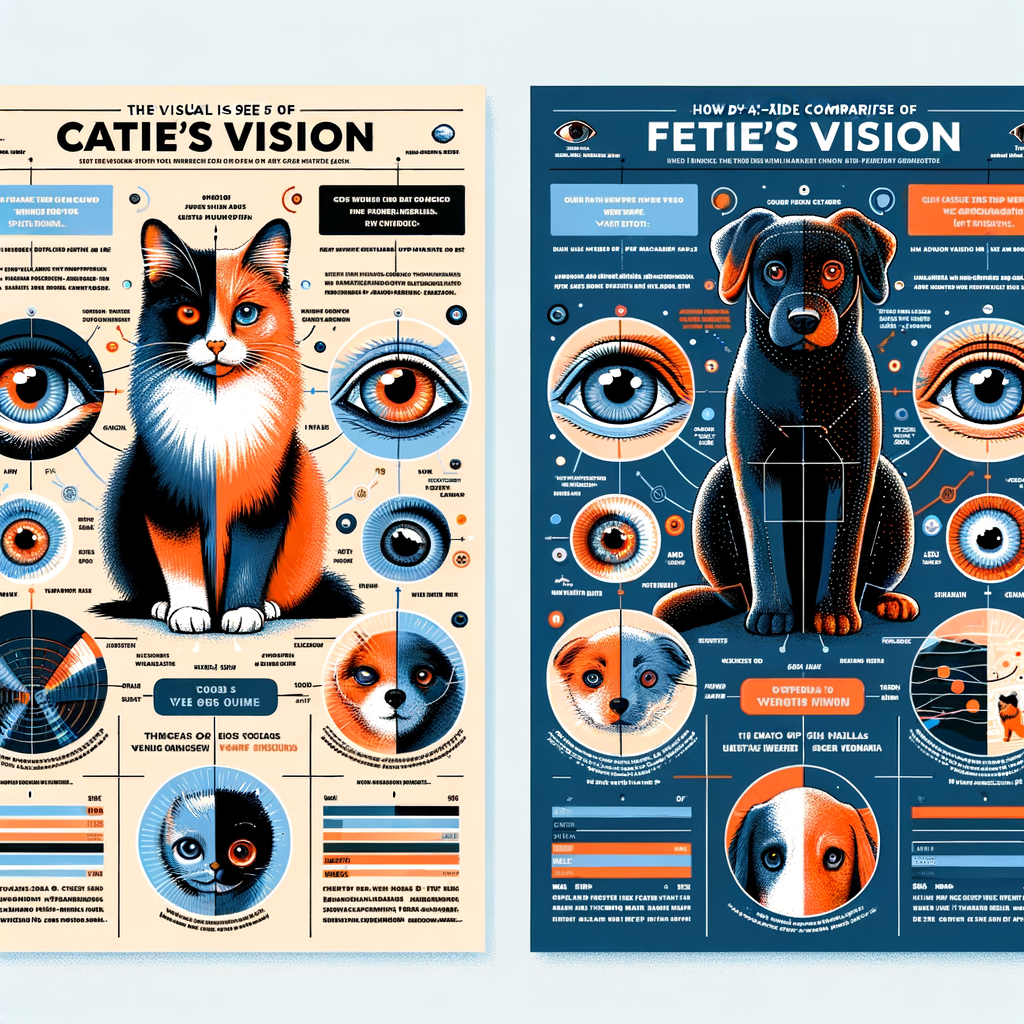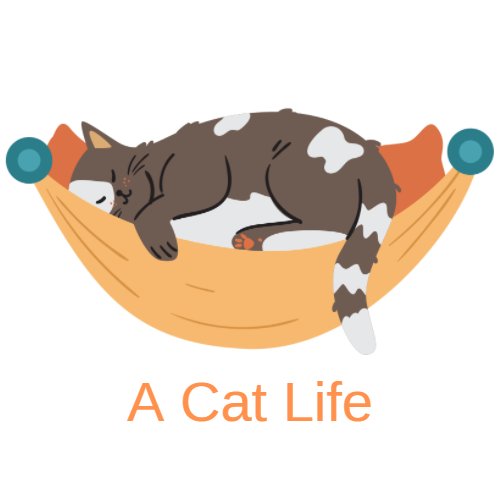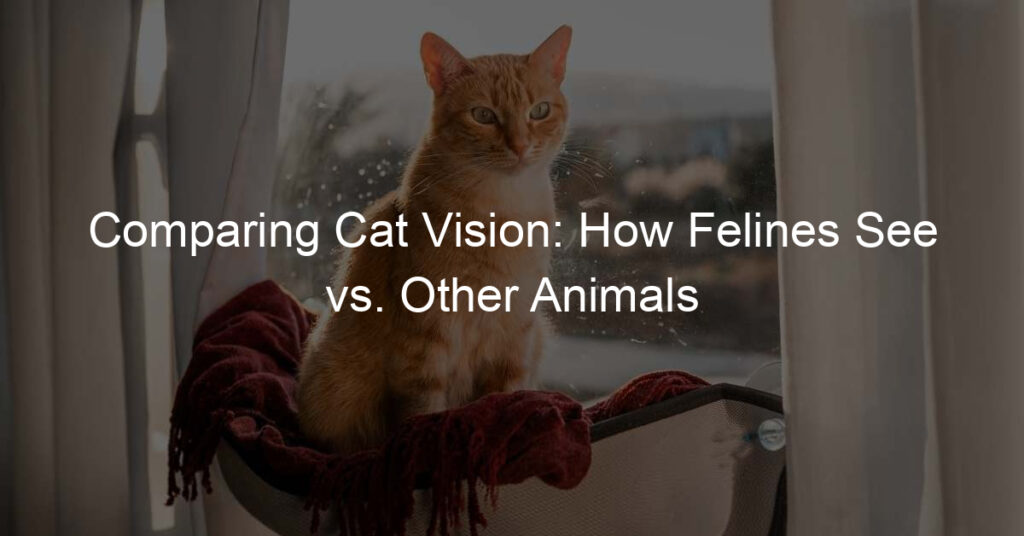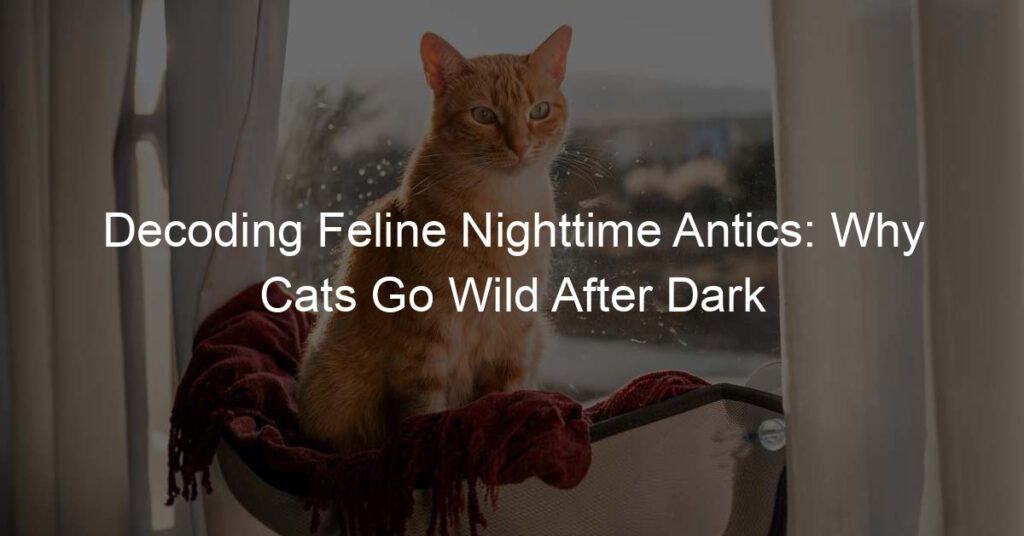
Introduction to Cat Vision
Have you ever wondered how your feline friend sees the world? Cats, like humans, rely on their vision to navigate their surroundings. However, a cat’s vision is quite different from ours. In this article, we will explore the fascinating world of cat vision, helping you understand how your furry friend perceives the world around them.
-
Understanding Cat’s Vision
Cats are natural hunters, and their vision is adapted to support this lifestyle. Unlike humans who have a wide range of color vision, cats see the world in shades of blue and yellow. This is because they lack the receptors for red and green colors. However, what they lack in color perception, they make up for in their ability to see in low light conditions.
Cats have a special layer at the back of their eyes called the tapetum lucidum, which reflects light back through the retina. This increases the amount of light available for the cat’s eyes to see, making them excellent night hunters. In fact, cats can see clearly in nearly total darkness, a feat that is impossible for humans.
-
Key Features of Feline Vision
There are several key features that make a cat’s vision unique:
- Field of View: Cats have a wider field of view than humans. While humans have a field of view of around 180 degrees, cats enjoy a field of view of 200 degrees.
- Depth Perception: Cats have excellent depth perception. This is because they use both of their eyes to focus on their prey, allowing them to judge distances accurately.
- Night Vision: As mentioned earlier, cats are excellent hunters in the dark. Their eyes have six to eight times more rod cells, which are sensitive to low light, than humans.
- Color Vision: Cats see the world in shades of blue and yellow. They lack the ability to see the full range of colors that humans can.
These features combine to give cats a unique way of seeing the world, perfectly adapted to their lifestyle as hunters.
Comparison of Animal Vision
When it comes to the animal kingdom, vision varies greatly between species. In this section, we will compare the vision of two common household pets: cats and dogs.
Cat Vision vs Dog Vision
Although both cats and dogs are beloved pets, their vision differs significantly. Let’s take a closer look at their visual acuity, color perception, and night vision.
- Visual Acuity
- Color Perception
- Night Vision
Visual acuity refers to the clarity of vision. In cats, it’s estimated to be around 20/100 to 20/200. This means that what a cat can see at 20 feet, a human can see at 100 or 200 feet. On the other hand, dogs have a visual acuity of around 20/75. So, while dogs see better than cats, neither sees as well as humans.
Contrary to popular belief, both cats and dogs can see color, but not as vividly as humans. Cats are believed to see blues and yellows best, but cannot distinguish between reds and greens. Dogs, however, see the world in shades of blue and yellow, but cannot perceive the range of colors that humans can.
When it comes to seeing in the dark, cats are the clear winners. Thanks to a high number of rod cells in their eyes, cats can see clearly in nearly total darkness. Dogs, while better than humans at seeing in low light, cannot match the night vision capabilities of cats.
In conclusion, while cats and dogs both have unique visual abilities, they perceive the world around them differently. Understanding these differences can help us better cater to their needs and enhance their quality of life.
Cat Vision vs Human Vision
When it comes to vision, cats and humans perceive the world in different ways. Let’s explore the differences in visual acuity, color perception, and night vision between cats and humans.
- Visual Acuity
- Color Perception
- Night Vision
Visual acuity refers to the sharpness of vision. In humans, perfect vision is often referred to as 20/20 vision. However, cats have a visual acuity of around 20/100 to 20/200. This means that what humans can clearly see at 100 or 200 feet, a cat would need to be 20 feet away to see with the same clarity. Despite this, cats excel in detecting movement, which aids them in hunting.
Unlike humans who can see a wide range of colors, cats have a more limited color perception. Humans have three types of color receptors, allowing them to see red, green, and blue. Cats, on the other hand, only have two types of color receptors, which are most sensitive to blue and yellow hues. This means that cats likely see the world in shades of blue and yellow, with less ability to perceive red and green.
One area where cats clearly outperform humans is in night vision. Cats are crepuscular creatures, which means they are most active during dawn and dusk. Their eyes are adapted to low light conditions, allowing them to see clearly even in nearly total darkness. Humans, on the other hand, struggle to see in low light conditions. This is due to the high number of rod cells in a cat’s eyes, which are light-sensitive cells that allow for superior night vision.
| Aspect of Vision | Cats | Humans |
|---|---|---|
| Visual Acuity | 20/100 to 20/200 | 20/20 |
| Color Perception | Blue and Yellow | Red, Green, and Blue |
| Night Vision | Superior | Inferior |
In conclusion, while humans may have sharper visual acuity and a broader range of color perception, cats have the upper hand when it comes to night vision. Understanding these differences can help us better appreciate the unique ways in which our feline friends experience the world.
How Cats See: A Detailed Look
Let’s take a closer look at how cats see the world. We will explore three main aspects: understanding the cat’s eyesight, how cats perceive movement, and how they perceive distance.
- Understanding the Cat’s Eyesight
Cats are known for their striking eyes. But, their eyes are not just beautiful; they are also quite unique in the way they function. Cats have a special kind of vision called crepuscular vision. This means they can see very well in low light conditions, like at dawn or dusk. This is because their eyes have more rods – the part of the eye that detects light and movement – than humans.
Additionally, cats’ eyes have a structure called the tapetum lucidum that reflects light back through the retina, enhancing their ability to see in the dark. This is why cats’ eyes seem to glow in the dark!
- How Cats Perceive Movement
Another fascinating aspect of a cat’s vision is their ability to perceive movement. Cats are natural hunters, and their eyes are designed to detect even the slightest movement. This is why your cat might suddenly pounce on a toy or a piece of string that you wiggle in front of them.
Research shows that cats can see movement twice as well as humans. This is due to the high number of rods in their eyes, which are sensitive to changes in light and movement.
- How Cats Perceive Distance
Finally, let’s talk about how cats perceive distance. Cats are nearsighted, which means they see objects close to them more clearly than those far away. This is perfect for hunting, as they can focus on their prey without getting distracted by far-off movements.
However, don’t worry if your cat seems to misjudge a jump from time to time. While their nearsightedness helps them in hunting, it can sometimes lead to miscalculations in distance when jumping or climbing.
In conclusion, a cat’s vision is a complex and fascinating system, perfectly adapted to their lifestyle and needs. From seeing in the dark to detecting the slightest movement, our feline friends truly have a unique way of looking at the world.
Feline Vision: Special Features
One of the most fascinating aspects of a cat’s vision is its ability to see in the dark. This is largely due to a special feature known as the Tapetum Lucidum.
Tapetum Lucidum: The Secret to Night Vision
The Tapetum Lucidum is a layer of cells located in a cat’s eyes. This layer acts like a mirror, reflecting light back through the retina and giving cats their famous glowing eyes in the dark. But it’s not just for show – it also has a very important function.
- What is Tapetum Lucidum?
- How does it enhance a cat’s sight capabilities?
The Tapetum Lucidum is a layer of cells located in the back of a cat’s eye. It’s like a built-in reflector, bouncing light back through the retina. This helps to increase the amount of light available for the cat’s eyes to detect, which is particularly useful in low-light conditions.
The Tapetum Lucidum enhances a cat’s sight by effectively doubling the amount of light available for the eyes to detect. When light enters a cat’s eye, it passes through the retina and hits the Tapetum Lucidum. This layer then reflects the light back through the retina, giving the photoreceptor cells a second chance to absorb the light. This process greatly improves a cat’s ability to see in the dark.
In essence, the Tapetum Lucidum is like a superpower that allows cats to see in near darkness. It’s one of the many special features that make feline vision so unique and effective.
Slit Pupils: More Than Just Aesthetic
When we look into a cat’s eyes, one of the most striking features is their slit-shaped pupils. But have you ever wondered why cats have slit pupils, and how these unique pupils contribute to their visual perception? Let’s delve into these questions.
- Why do cats have slit pupils?
- How do slit pupils contribute to cat’s visual perception?
Unlike humans who have round pupils, cats have vertical slit pupils. This is not just for aesthetic appeal. Cats are both predators and prey in the wild, and their slit pupils play a crucial role in their survival. Slit pupils allow cats to control the amount of light entering their eyes more precisely. This is particularly useful in bright light conditions, where the slits can narrow to a tiny line, protecting the sensitive retina from damage.
Slit pupils give cats a distinct advantage in terms of visual perception. The vertical orientation of the slits allows cats to judge distance and depth more accurately, which is crucial when hunting. Moreover, when the pupils expand in low light, they cover a larger area of the retina, enabling cats to see better in the dark. This is why cats are such efficient nocturnal hunters.
In summary, the slit pupils of cats are more than just an aesthetic feature. They are a sophisticated adaptation that enhances their visual perception, enabling them to be efficient hunters and survive in various lighting conditions.
| Feature | Function |
|---|---|
| Slit Pupils | Control light intake, judge distance and depth, enhance night vision |
Vision Differences in Animals: Case Studies
Let’s delve into some fascinating case studies to understand how vision varies in different animals. Our first case study compares the visual capabilities of domestic cats and wild cats.
Case Study 1: Domestic Cats vs Wild Cats
Domestic cats and wild cats, while belonging to the same family, have evolved differently due to their distinct environments. This has resulted in some interesting differences in their visual capabilities.
- Comparison of visual capabilities
- Adaptations to different environments
Domestic cats have excellent night vision, which is nearly six times better than that of humans. They have a wider field of view and can see clearly even in dim light. This is because of a special layer in their eyes called the tapetum lucidum, which reflects light back through the retina and enhances night vision.
On the other hand, wild cats, like lions and tigers, have even more enhanced night vision. Their eyes are larger and have a higher concentration of rod cells, which are responsible for detecting light and dark. This allows them to hunt effectively even in near-total darkness.
Domestic cats, living in close proximity to humans, have adapted to indoor lighting conditions. Their eyes have a higher number of cone cells, which help in distinguishing colors. This is why domestic cats can see some colors, though not as vividly as humans.
Wild cats, however, live in varied environments – from dense forests to open savannahs. Their eyes have adapted to these conditions. For instance, the eyes of a tiger are positioned in the front of its head, giving it a good depth perception for hunting. Similarly, a cheetah’s eyes have a wide field of view to spot prey from a distance.
In conclusion, both domestic and wild cats have impressive visual capabilities, each adapted to their specific environments. Whether it’s the domestic cat’s ability to see in dim light or the wild cat’s enhanced night vision, these adaptations are a testament to the marvels of nature.
Case Study 2: Cats vs Birds of Prey
Let’s dive into an intriguing comparison between the visual capabilities and hunting adaptations of cats and birds of prey.
- Comparison of Visual Capabilities
Cats and birds of prey, such as eagles and hawks, have unique visual capabilities that set them apart in the animal kingdom. While both have excellent night vision, the similarities end there.
| Cats | Birds of Prey | |
|---|---|---|
| Field of View | 200 degrees | 340 degrees |
| Color Perception | Less vibrant colors | More vibrant colors |
| Detail Perception | Less detail | More detail |
As the table shows, birds of prey have a wider field of view and can see more vibrant colors and details than cats. However, cats have a wider peripheral vision which allows them to detect movement better.
- Adaptations to Different Hunting Styles
Both cats and birds of prey are skilled hunters, but their hunting styles are quite different due to their unique adaptations.
Cats are solitary hunters who rely on stealth and surprise. Their eyes are adapted for low light conditions, allowing them to hunt at dawn and dusk when their prey is most active. They also have a tapetum lucidum, a layer of cells in the eye that reflects light back through the retina, enhancing night vision.
On the other hand, birds of prey are daytime hunters. Their eyes are adapted for long-distance vision, enabling them to spot prey from high in the sky. They also have a high number of cones in their eyes, allowing them to see a wider range of colors and detect the slightest movements.
In conclusion, while cats and birds of prey have different visual capabilities and hunting adaptations, both are perfectly equipped for their specific hunting styles.
Conclusion: Understanding Cat’s Vision
As we conclude our exploration of cat vision, it’s clear that our feline friends perceive the world in a unique and fascinating way. Let’s summarize the key takeaways and discuss what these insights mean for pet owners.
- Key takeaways about cat’s vision
- Implications for pet owners
Cats have a different visual perspective compared to humans. They see fewer colors, but their vision is superior in low light conditions. Cats have a wider field of view and can detect rapid movements better than humans. Their eyes are adapted for hunting, with a focus on detecting motion and seeing clearly in the dark.
Understanding your cat’s vision can help you provide a more comfortable and stimulating environment for them. For instance, you might want to provide toys that move or make noise to engage your cat’s keen sense of motion detection. Similarly, understanding that cats can see well in the dark can help you understand their nocturnal behaviors.
In conclusion, appreciating the unique aspects of cat vision can enhance our relationship with our feline friends. It allows us to better understand their needs, behaviors, and preferences, leading to a happier and healthier pet.








